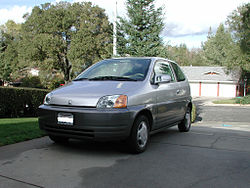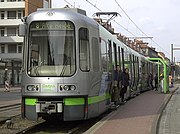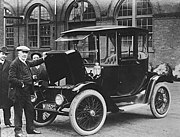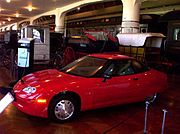Honda EV Plus
| Honda EV Plus | |
|---|---|
 | |
| Manufacturer | Honda |
| Production | 1997-1999 about 300 produced |
| Class | Battery electric vehicle |
| Wheelbase | 99.6 in (2.53 m) |
| Length | 159.3 in (4.05 m) |
| Width | 68.9 in (1.75 m) |
| Height | 64.2 in (1.63 m) |
| Curb weight | 1630 kg (3590 lb) |
The Honda EV Plus was the first production battery electric vehicle from a major automaker with non lead acid batteries. About 340 or so EV Plus models were produced and released. The EV Plus was taken out of production in 1999 when Honda announced the release of it's first hybrid electric vehicle, the Honda Insight. The EV Plus was made to meet California Air Resources Board requirements for zero-emission vehicles, the same as General Motors' new EV1.
The EV Plus featured on-board conductive charging with the Avcon connector, regenerative braking, AC/heat-pump climate control, HID headlights, 4 seats, and electrically heated windshield. As with virtually all vehicles, range was affected by driving style: rapid acceleration, high speeds, and fast stops lowered the range. Careful driving would give it a range of over 100 miles (160 km). The EV came with a 12 V battery for running normal 12 volt accessories.
EV Plus Specs
- Track Front/Rear: 59.1 in/58.7 in (1.50 m/1.49 m)
- Drive Train: Front Wheel Drive
- Occupants: Four
- Voltage: 288 V
- Motor: DC Brushless
- Power: 49 kW (66 hp)
- Battery (24) 12 V NiMH
- Charger: On-board Conductive
- Recharge: 6 hours
- Acceleration: 4.9 s (0-30 mph)
- Maximum Speed: 80+ mph (130 km/h)
- Range: 100 miles or 160 km (80% discharge). Up to 120 miles (190 km) range under ideal conditions.
- Lease Cost: $455/mo for 36 mo.
The EV Plus was listed with an MSRP of $53,000, but Honda never allowed them to be sold, instead offering the cars on a 3-year, lease-only program. Honda allowed some customers to extend their EV Plus lease for a few years. At the end of the leases, all EV Plus cars were taken back by Honda and decommissioned.
Vehicles also featured:
Electric vehicle

An electric vehicle, or EV, is a vehicle with one or more electric motors for propulsion. This is also referred to as an electric drive vehicle. The motion may be provided either by wheels or propellers driven by rotary motors, or in the case of tracked vehicles, by linear motors.
Unlike an internal combustion engine that is tuned to specifically operate with a particular fuel such as gasoline or diesel. An electric drive vehicle needs electricity which could come from sources such as batteries, fuel cells or a generator. This flexibility allows the drive train of the vehicle to remain the same, while the fuel source can be changed.
The energy used to propel the vehicle may be obtained from several sources, some of them more ecological than others:
- on-board rechargeable energy storage system (RESS), called Full Electric Vehicles (FEV). Power storage methods include:
- chemical energy stored on the vehicle in on-board batteries: Battery electric vehicle (BEV)
- static energy stored on the vehicle in on-board supercapacitors
- kinetic energy storage: flywheels
- direct connection to land-based generation plants, as is common in electric trains and trolley buses (See also : overhead lines, third rail and conduit current collection)
- renewable sources such as wind or solar
- generated on-board using a fuel cell: fuel cell vehicle
- generated on-board using nuclear energy, on nuclear submarines and aircraft carriers
It is also possible to have hybrid electric vehicles that derives energy from multiple sources. Such as:
- on-board rechargeable energy storage system and a direct continuous connection to land-based generation plants for purposes of on-highway recharging with unrestricted highway range
- on-board rechargeable energy storage system (RESS) and a fueled propulsion power source (internal combustion engine): including the diesel-electric locomotive & plug-in hybrid
Electric vehicles can include electric airplanes, electric boats, and electric motorcycles and scooters.
History
Electric motive power started with a small railway operated by a miniature electric motor, built by Thomas Davenport in 1835. In 1838, a Scotsman named Robert Davidson built an electric locomotive that attained a speed of four miles an hour. In England a patent was granted in 1840 for the use of rails as conductors of electric current, and similar American patents were issued to Lilley and Colten in 1847.
Between 1832 and 1839 (the exact year is uncertain), Robert Anderson of Scotland invented the first crude electric carriage, powered by non-rechargeable Primary cells.
By the 20th century, electric cars and rail transport were commonplace, with commercial electric automobiles having the majority of the market. Over time their general-purpose commercial use reduced to specialist roles, as platform trucks, forklift trucks, tow tractors and urban delivery vehicles, such as the iconic British milk float.
Electrified trains were used for coal transport as the motors did not use precious oxygen in the mines. Switzerland's lack of natural fossil resources forced the rapid electrification of their rail network. One of the earliest rechargeable batteries - the Nickel-iron battery - was favored by Edison for use in electric cars.
Electric vehicles were among the earliest automobiles, and before the preeminence of light, powerful internal combustion engines, electric automobiles held many vehicle land speed and distance records in the early 1900s. They were produced by Baker Electric, Columbia Electric, Detroit Electric, and others and at one point in history out-sold gasoline-powered vehicles.
In the 1930s, National City Lines, which was a partnership of General Motors, Firestone, and Standard Oil of California purchased many electric tram networks across the country to dismantle them and replace them with GM buses. The partnership was convicted of conspiring to monopolize the sale of equipment and supplies to their subsidiary companies conspiracy, but were acquitted of conspiring to monopolize the provision of transportation services. Electric tram line technologies could be used to recharge BEVs and PHEVs on the highway while the user drives, providing virtually unrestricted driving range. The technology is old and well established (see : Conduit current collection, Nickel-iron battery). The infrastructure has not been built.
In January of 1990, General Motors' President introduced its EV concept two-seater, the "Impact," at the Los Angeles Auto Show. That September, the California Air Resources Board mandated major-automaker sales of EVs, in phases starting in 1998. From 1996 to 1998 GM produced 1117 EV1s, 800 of which were made available through 3-year leases.
Chrysler, Ford, GM, Honda, Nissan and Toyota also produced limited numbers of EVs for California drivers. In 2003, upon the expiration of EV1 leases, GM crushed them. The crushing has variously been attributed to 1) the auto industry's successful Federal Court challenge to California's Zero-emissions vehicle mandate, 2) a federal regulation requiring GM to produce and maintain spare parts for the few thousands EV1s and 3) the success of the Oil and Auto industries' media campaign to reduce public acceptance of electric vehicles.
A movie made on the subject in 2005-2006 was titled Who Killed the Electric Car? and released theatrically by Sony Pictures Classics in 2006. The film explores the roles of automobile manufacturers, oil industry, the US government, batteries, hydrogen vehicles, and consumers, and each of their roles in limiting the deployment and adoption of this technology.
Honda, Nissan and Toyota also repossessed and crushed most of their EVs, which, like the GM EV1s, had been available only by closed-end lease. After public protests, Toyota sold 200 of its RAV EVs to eager buyers; they now sell, five years later, at over their original forty-thousand-dollar price.
Currently, only a few electric cars are commercially available, including:
- The REVA, manufactured in India since 2001 for the Indian market, then also commercialized in the UK (since 2003) and several other European countries (including Cyprus and Greece, Belgium, Germany, Spain and Norway).
- The Tesla Roadster, commercialized in the USA.
- Several smaller electric vehicles, most of which are only commercialized locally (see the list of production battery electric vehicles)
Energy sources

(See articles on diesel-electric and gasoline-electric hybrid locomotion for information on electric vehicles using internal-combustion energy sources).
Batteries, supercapacitors and flywheel energy storage are forms of rechargeable on-board electrical storage. By avoiding an intermediate mechanical step, the energy conversion efficiency can be improved over the hybrids already discussed, by avoiding unnecessary energy conversions. Furthermore, electro-chemical batteries conversions are easy to reverse, allowing electrical energy to be stored in chemical form.
Another form of chemical to electrical conversion is fuel cells, projected for future use.
For especially large electric vehicles, such as submarines, the chemical energy of the diesel-electric can be replaced by a nuclear reactor. The nuclear reactor usually provides heat, which drives a steam turbine, which drives a generator, which is then fed to the propulsion. See Nuclear Power
Electric motor
The power of a vehicle electric motor, as in other vehicles, is measured in kW. 100 kW is roughly equivalent to 134 horsepower, although most electric motors deliver full torque at any speed, so the performance is not equivalent, and far exceeds a 134 horsepower fuel powered motor, which has a limited torque curve.
Large-scale electric transport: energy and motors

Most large electric transport systems are powered by stationary sources of electricity that are directly connected to the vehicles through wires. Due to the extra infrastructure and difficulty in handling arbitrary travel, most directly connected vehicles are owned publicly or by large companies. These forms of transportation are covered in more detail in metros, trams, electric locomotives, and trolleybuses.
In the systems above motion is provided by a rotary electric motor. However, it is possible to "unroll" the motor to drive directly against a special matched track. These linear motors are used in maglev trains which float above the rails supported by magnetic levitation. This allows for almost no rolling resistance of the vehicle and no mechanical wear and tear of the train or track. Levitation and forward motion are two independent effects; the forward motive force normally requires external power, although some types, such as Inductrack, achieve levitation at low speeds without any. In addition to the high-performance control systems needed, switching and curving of the tracks becomes difficult with linear motors, which to date has restricted their operations to high-speed point to point services.
Small scale electric vehicles

Some bicycles have been converted to electric power with a small battery and a small electric motor, some even have solar panels that are folded out when the vehicle is at rest. Small scale electric vehicles include electric cars, light trucks, neighborhood electric vehicles, motorcycles, motorized bicycles, electric scooters , golf carts, milk floats, forklifts and similar vehicles.
Issues regarding electric vehicles
Although electric vehicles have few direct emissions, all rely on energy created through electricity generation which will emit pollution unless it is generated by power plants that do not use fossil fuels, such as renewable source or nuclear power plants. Even with power plants emitting CO2, the overall levels would be reduced because the entire process of moving a car is more efficient using electricity than producing gasoline and burning it in a car's engine.
If a large proportion of private vehicles were to convert to plug-in electricity, the existing power plant and transmission infrastructure would be nearly sufficient, assuming most charging occurred overnight using the most efficient off-peak base load sources. But there would be a significant need for additional resources (and emissions) in generation. However, the overall energy consumtion would diminish because of the higher efficiency of electric vehicles over the entire cycle.
Electromagnetic radiation from high performance electrical motors has been claimed to be associated with some human ailments, but such claims are largely unsubstanciated except for extremely high exposures. Electric motors can be shielded within a metallic Faraday's cage, but this adds weight to the vehicle and it is not conclusive that all electromagnetic radiation can be contained.
Issues with batteries

On an energy basis, the price of electricity to run an EV is a small fraction as much as liquid fuel. Issues related to batteries, however, can add to the operating costs.
Lead-acid
Traditionally, most EVs have used lead-acid batteries due to their mature technology, high availability, and low cost (exception: some early EVs, such as the Detroit Electric, used nickel-iron.) Like all batteries, these have an environmental impact through their construction, use, disposal or recycling. On the upside, vehicle battery recycling rates top 95% in the United States. Deep-cycle lead batteries are expensive and have a shorter life than the vehicle itself, typically needing replacement every 3 years.
Lead-acid batteries in EV applications end up being a significant (25%-50%) portion of the final vehicle mass. Like all batteries, they have significantly lower energy density than petroleum fuels -- in this case, 30-40Wh/kg. While the difference isn't as extreme as it first appears due to the lighter drivetrain in an EV, even the best batteries tend to lead to higher masses when applied to vehicles with a normal range. The efficiency and storage capacity of the current generation of common deep cycle lead acid batteries decreases with lower temperatures, and diverting power to run a heating coil reduces efficiency and range by up to 40%. Recent advances in battery efficiency, capacity, materials, safety, toxicity and durability are likely to allow these superior characteristics to be applied in car-sized EVs.
Charging and operation of batteries typically results in the emission of hydrogen, oxygen and sulfur, which are naturally occurring and normally harmless if properly vented. Early Citicar owners discovered that, if not vented properly, unpleasant sulfur smells would leak into the cabin immediately after charging.
Lead-acid batteries have been re-engineered by Firefly Energy, increasing longevity, slightly increasing energy density, and significantly increasing power density. Firefly is expected market lightweight vehicle batteries, either directly or through manufacturing partners in 2008.
Lead-acid batteries powered such early-modern EVs as the original versions of the EV1 and the RAV4EV.
Nickel metal hydride
Nickel-metal hydride batteries are now considered a relatively mature technology. While less efficient in charging and discharging than even lead-acid, they boast an energy density of 30-80Wh/kg, far higher than lead-acid. When used properly, nickel-metal hydride batteries can have exceptionally long lives, as has been demonstrated in their use in hybrid cars and surviving NiMH RAV4EVs that still operate well after 100,000 miles and over a decade of service. Downsides include the poor efficiency, high self-discharge, very finicky charge cycles, and poor performance in cold weather.
Zebra
The sodium or "zebra" battery uses a molten chloroaluminate (NaAlCl4) salt as the electrolyte. Also a relatively mature technology, the Zebra battery boasts a good energy density of 90Wh/kg and near lossless charge/discharge cycles. Since the battery must be heated for use, cold weather doesn't strongly affect its operation except for in increasing heating costs. It has been used in several EVs. The downsides to the Zebra battery include poor power density and the requirement of having to heat the electrolyte, which wastes energy and presents difficulties in long-term storage of charge. Zebras can last for a few thousand charge cycles and are nontoxic.
Lithium ion
Lithium-ion (and similar lithium polymer) batteries, widely known through their use in laptops and consumer electronics, dominate the most recent group of EVs in development. The traditional lithium-ion chemistry involves a lithium cobalt oxide cathode and a graphite anode. This yields cells with an impressive 160Wh/kg energy density and good power density, and near lossless charge/discharge cycles. The downsides of traditional lithium-ion batteries include short cycle lifes (hundreds to a few thousand charge cycles) and significant degradation with age. The cathode is also somewhat toxic. Also, traditional lithium-ion batteries can pose a fire safety risk if punctured or charged improperly. The maturity of this technology is moderate. The Tesla Roadster uses "blades" of traditional lithium-ion "laptop battery" cells that can be replaced individually as needed.
Most other EVs are utilizing new variations on lithium-ion chemistry that sacrifice energy density (often resulting in batteries with 100Wh/kg or less) to provide extreme power density, fire resistance, environmental friendliness, very rapid charges (as low as a few minutes), and very long lifespans. These variants (phosphates, titanates, spinels, etc) have been shown to have a much longer lifetime, with A123 expecting their lithium iron phosphate batteries to last for at least 10+ years and 7000+ charge cycles, and LG Chem expecting their lithium-manganese spinel batteries to last up to 40 years.
Much work is being done on lithium ion batteries in the lab. Lithium vanadium oxide has already made its way into the Subaru prototype G4e, doubling energy density. Silicon nanowires, silicon nanoparticles, and tin nanoparticles promise several times the energy density in the anode, while compositeand superlattice athodes also promise significant density improvements.
Other in-development technologies
Conventional supercapacitors are being worked to achieve the energy density of lithium ion batteries, offering almost unlimited lifespans and no environmental issues. High-K supercapacitors, such as EEStor's EESU, promise to best lithium ion energy density several times over if they can be produced. Lithium-sulphur batteries offer 250Wh/kg. Sodium-ion batteries promise 400Wh/kg with only minimal expansion/contraction during charge/discharge and a very high surface area.
Battery replacement is also proposed as an alternative. While it suffers from some problems (weight, standardization, etc), Project Better Place has already raised several hundred million dollars to build networks of charging and battery replacement stations. One type of battery "replacement" proposed is much simpler: while the latest generation of vanadium redox battery only has an energy density similar to lead-acid, the charge is stored solely in a vanadium-based electrolyte, which can be pumped out and replaced with charged fluid.
Advantages of electric vehicles
Electric motors are mechanically very simple, and release almost no air pollutants at the place where they are operated.
Electric motors often achieve 90% energy conversion efficiency over the full range of speeds and power output and can be precisely controlled. They can also be combined with regenerative braking systems that have the ability to convert movement energy back into stored electricity. This can be used to reduce the wear on brake systems (and consequent brake pad dust) and reduce the total energy requirement of a trip, especially effective for start-and-stop city use.
They can be finely controlled and provide high torque from rest, unlike internal combustion engines, and do not need gears to match power curves. This removes the need for gearboxes and torque converters.
Another advantage is that electric vehicles typically have less vibration and noise pollution than a vehicle powered by an internal combustion engine, whether it is at rest or in motion.
Incentives
USAQualifying electric vehicles purchased new are eligible for a one-time federal tax credit that equals 10% of the cost of the vehicle up to $4,000, provided under Section 179A of the Energy Policy Act of 1992; it was extended through 2007 by the Working Families Tax Relief Act of 2004.
A tax deduction of up to $100,000 per location is available for qualified electric vehicle recharging property used in a trade or business.
European Union
Directive 2006/32/EC of the European Parliament and of the Council of 5 April 2006 on energy end-use efficiency and energy services includes measures to promote efficient vehicles.
AVERE has a table summarizing the taxation and incentives for these vehicles in the different European countries, related to state subsidies, reduction of VAT and other taxes, insurance facilities, parking and charging facilities (including free recharging on street or in the parkings), EV imposed by law and banned circulation for petroleum cars, permission to use bus lanes and toll free on highways, between others.
Estimated number of electric vehicles
The Energy Information Administration (EIA) estimates that were 55,852 Full-Electric Vehicles (FEV) in 2004, with an annual growth rate of 39.1 % (excluding in this estimation electric hybrids).
Production
The only EV to have been manufactured for several years is the Indian REVA. It is produced by REVA Electric Car Company Private Ltd. (RECC) in Bangalore, India, a company established in 1994 as a joint venture between the Maini Group India and AEV LLC, California USA. After seven years of R&D, they commercialized the first REVA car in June 2001.
The current version of the REVA is the REVAi. It was first reserved for the Indian market, but it is now distributed in several European countries: UK (by GoinGreen under the name G-Wiz), Cyprus and Greece (by REVA Phaedra Electricity Mobility Ltd, Belgium (by Green Mobil), Norway (by Ole Chr. Bye AS), Spain (by Emovement)and Germany (by Elektro PKW). It may be exported to the USA with a speed limiter for use as a Neighborhood Electric Vehicle (NEV).
Most of the EVs that Chrysler, Ford, GM (EV1), Honda, Nissan and Toyota produced in limited numbers for California drivers were crushed.
The production of the Citroën Berlingo Electrique stopped in September 2005.
Several Industry giants, such as Daimler AG, Toyota Motor Corp., General Motors Corp., Renault SA and Mitsubishi Corp., are developing new-generation electric vehicles.
European Union
Portugal and Spain
Portugal and Spain want to create the first green car in Iberia, hoping to generate 150 million euros worth of investment and 800 new jobs in the region's struggling motor industry. The green car, which could be powered by electricity. The Mobi-green car, as the vehicle is named, is being developed by two automotive research centres in Portugal and Spain using funds from both the public and private sectors.
Future


Several start-up companies like Tesla Motors, Ronaele Incorporated, Commuter Cars, Phoenix Motorcars, Miles Electric Vehicles, and Aptera Motors will have powerful battery-electric vehicles available to the public in 2008. Battery and energy storage technology is advancing rapidly. The average distance driven by 80% of citizens per day in a car in the US is about 50 miles (US dept of transport, 1991), which fits easily within the current range of the electric car. This range can be improved by technologies such as Plug-in hybrid electric vehicles which are capable of using traditional fuels for unlimited range, rapid charging stations for BEVs, improved energy density batteries, flow batteries, or battery swapping.
In October 29th 2007, Shai Agassi launched Project Better Place, a company focused on building massive scale Electric Recharge Grids as infrastructure supporting the deployment of electric vehicles (including plug-in hybrids) in countries around the world. In January 21st, BPP and the Nissan-Renault group signed a MOU - PBP will provide the battery recharging and swapping infrastructure and Renault-Nissan will mass-produce the vehicles.
Improved long term energy storage and nano batteries
There have been several developments which could bring electric vehicles outside their current fields of application, as scooters, golf cars, neighborhood vehicles, in industrial operational yards and indoor operation. First, advances in lithium-based battery technology, in large part driven by the consumer electronics industry, allow full-sized, highway-capable electric vehicles to be propelled as far on a single charge as conventional cars go on a single tank of gasoline. Lithium batteries have been made safe, can be recharged in minutes instead of hours, and now last longer than the typical vehicle. The production cost of these lighter, higher-capacity lithium batteries is gradually decreasing as the technology matures and production volumes increase.
Introduction of Battery Management and Intermediate Storage
Another improvement is to decouple the electric motor from the battery through electronic control, employing ultra-capacitors to buffer large but short power demands and regenerative braking energy. The development of new cell types combined with intelligent cell management improved both weak points mentioned above. The cell management involves not only monitoring the health of the cells but also a redundant cell configuration (one more cell than needed). With sophisticated switched wiring it is possible to condition one cell while the rest are on duty.
Electric Vehicle Organizations
Worldwide
The World Electric Vehicle Association (WEVA), chairman Hisashi Ishitani, formed by:
- Electric Drive Transportation Association (EDTA)
- Electric Vehicle Association of Asia Pacific (EVAAP)
- European Association for Battery, Hybrid and Fuel Cell Electric Vehicles (AVERE)
North America
- Seattle Electric Vehicle Association
- NEDRA National Electric Drive Racing Association
- The Electric Auto Association (EAA) (North America) and its chapter Plug In America.
- Electric Car Society





















![Validate my RSS feed [Valid RSS]](valid-rss-rogers.png)















































































ไม่มีความคิดเห็น:
แสดงความคิดเห็น